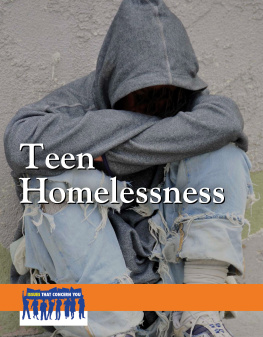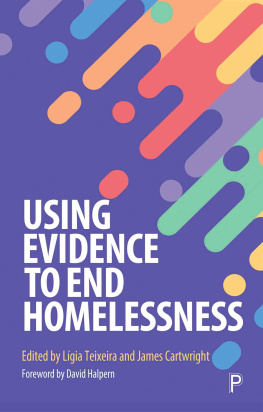Homelessness among Young People in Prague
A Narrative Analysis of Developmental Trajectories
Marie Vgnerov
Ladislav Csmy
Jakub Marek
Reviewed by:
Prof. PhDr. Zdenk Helus, DrSc.
Doc. PaedDr. Eva otolov, Ph.D.
Published by Charles University in Prague
Karolinum Press
English translation by Phil Jones
Editor Martin Janeek
Cover by Anna Issa otolov, layout by Jan erch Documentary photo by Dana Kyndrov, Anna Pospilov and Ladislav Kmr Typesetting by Karolinum Press
First English edition
Charles University in Prague, 2014
Marie Vgnerov, Ladislav Csmy, Jakub Marek, 2014
Translation Phil Jones, 2014
ISBN 978-80-246-2517-1
ISBN 978-80-246-2587-4 (online : pdf)
ISBN 978-80-246-3048-9 (ePub)
ISBN 978-80-246-3047-2 (Kindle)
FOREWORD TO THE ENGLISH EDITION
The generosity of Karolinum Press has made it possible for an English translation of this book on the lives of young homeless people to be made accessible to a wider readership. The Czech edition of the book came out in 2013 and was the first comprehensive analysis of the psychosocial and developmental psychological context of homelessness in the Czech Republic. As the authors, we feel it incumbent upon ourselves to offer a short foreword to the book for readers living in other countries.
Readers in more advanced economies may well be surprised to discover that the first publication on homelessness was only published in the Czech Republic in 2013. A short historical detour might be useful in this respect. After the Second World War what was then the Czechoslovak Republic, along with other Central and Eastern European countries, found itself within the sphere of influence of the Soviet Union. In 1948 the Communist Party came to power and a period of single-party government began that lasted four decades. One of the basic attributes of the totalitarian regime was the attempt to control the way that people thought by means of communist ideology and the imposition of draconian restrictions on access to information. The way that people behaved was subject to the same control. The right to work was transformed into a statutory duty to work. The farcical nature of this situation was epitomised by practically full employment and the criminal prosecution of those who for whatever reasons avoided this duty. Another instrument for enforcing control over people was the duty to report ones permanent or temporary residence. Needless to say, homeless was not and could not be a social problem under the conditions of the totalitarian social system. The rapid collapse of the totalitarian regimes of Central and Eastern Europe in autumn 1989 revealed not only the internal weaknesses of the system, but above all peoples craving for freedom. The turning point in the Czech Republic was the Velvet Revolution, personified by the charismatic figure of Vclav Havel. The country immediately set about reintroducing democratic social principles and economic transformation. The quarter of a century that has elapsed since that time has shown how difficult this is. The restoration of freedom was accompanied by both pleasure in the large gains made and anxiety resulting from the necessity to deal with the social problems that accompany freedom and a modern social organization. These problems include unemployment, new forms of criminality, corruption, drug abuse and homelessness. Society was forced to reflect upon these problems and to begin taking various measures to resolve them. Homelessness was never regarded as a priority. From the very start it was left to charities and NGOs to sort out. It gradually became clear that dealing with homelessness would require greater integration into the system of state-supported social services. The systematic resolution of homelessness is part of the Social Inclusion Strategy 20142020 unveiled by the government at the beginning of 2013. Another input was the results of the Census of People, Houses and Apartments 2011, which included a census of homeless people. In terms of homelessness, 11,496 met the criteria of the Czech Statistical Office. However, these results must be regarded as approximate, since they included only persons in contact with an institution at the time the census was taken, and the Czech Statistical Office itself says that the genuine number of homeless people in the Czech Republic may be far higher. Our research, which was conducted from 2010 to 2012, must therefore be regarded in the light of what has been written above.
Why have we focused on young homeless people? The findings of employees working at centres for the homeless indicate that young people comprise a relatively high proportion of the homeless. When defining the objectives of our research project we were aware that our findings regarding the lives of young homeless people could be valuable in respect of the process of their reintegration into society. Our research took in older adolescents and young adults aged 18 to 26. We did not include younger teenagers and minors, i.e. persons below the age of 18. This is because these young people are covered by the Act on the Social and Legal Protection of Children. Under this law and the provisions relating to it, minors cannot practically speaking remain on the street for any longer period of time. Of course, there are cases in which a dysfunctional family is incapable of looking after an underage child or a young person runs away from home and finds themselves on the street. However, in such cases after a certain period of time has elapsed they are returned to their family or placed in institutional care, usually in a childrens home or juvenile detention centre.
As far as research methodology is concerned, we combined a qualitative and quantitative approach. We based our work largely on analyses of structured interviews and responses to visual stimuli (selected thematic apperception tests (TAT) and original pictures created especially for this project). During the qualitative part of the research we administered the Eysenck personality questionnaire and the Brief Symptom Inventory (BSI), with the aim of supplementing the quantitative analysis with the personality characteristics of those questioned and their psychopathological profile.
We will leave it to our readers to judge to what extent we managed to contribute to the recognition and understanding of the causes and course of homelessness among young people. We believe that this book will be of interest to students and teachers involved in the humanities, professionals working in the caring professions, and those members of the general public interested in the social problems of our time.
The authors
Prague, 17 September 2013
1.
THE LIFE STORIES OF YOUNG HOMELESS PEOPLE
1.1 INTRODUCTION
Chronic homelessness can be perceived as a syndrome characterised by comprehensive social failure, which is manifest in an inability to accept and deal with everyday social requirements. It is usually accompanied by many other problems caused by the interaction of undesirable personality traits and adverse life experiences, i.e. an accumulation of stressful situations that a person finds difficult to deal with subjectively. Homelessness is a complex phenomenon that is not simply about the lack of shelter. This is now accepted by most specialists in the field. Prdkov and Novotn (2008) point out that, along with the loss of accommodation, homelessness is linked with the












